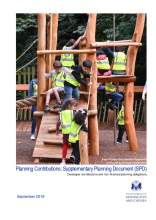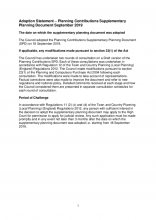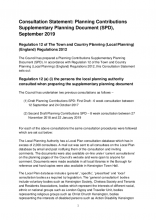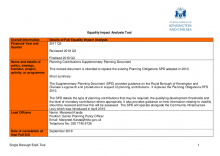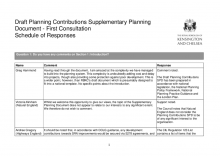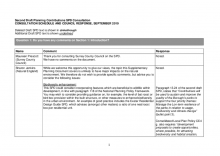Section 106
Planning Contributions Governance
A Planning Contributions Governance document has been adopted by the Council. This provides an overview of the governance processes for securing and allocating section 106 (s106) and Community Infrastructure Levy (CIL).
View the Planning Contributions Governance document.
Planning Contributions Supplementary Planning Document (SPD)
The Council adopted the Planning Contributions SPD on 18 September 2019. This replaces the previous Planning Obligations SPD 2010. The SPD provides guidance on Policy C1 of the Local Plan 2019, relating to planning contributions. The SPD sets out a formula for developer contributions for each relevant item to ensure that the process of securing planning contributions is transparent and robust.
Further details relating to the production of the SPD can be viewed here.
Planning Contributions Calculator
All applications that require a Section 106 agreement also need a planning contributions statement. The planning contributions statement should be accompanied with names and addresses of all those with an interest in the land to be bound by the planning obligations and written confirmation from all of the above that they will enter the Section 106 agreement or undertaking.
You will need to sign and date your statement and provide it with your planning application.
The Council has prepared a planning contributions calculator to help you prepare the planning contributions statement.
- Planning Document Calculator and Planning Contributions Statement: Guidance Notes
-
The Planning Contributions SPD was adopted in September 2019. This takes account of government best practice and sets out the range of planning obligations that may be secured to ensure that developments provide the necessary infrastructure to enable them to proceed.
The SPD provides clarity and transparency to applicants, residents and planning officers in calculating s106 contributions. It details the type of planning contributions that may be required, the qualifying development thresholds and the level of financial contribution where appropriate.
Applicants are required to submit a Planning Contributions Statement prior to planning applications being registered by the Council. This Planning Contributions Statement provides an overview of the development proposed and will inform the ‘Head of Terms’ of a legal agreement.
The Council operates Community Infrastructure Levy (CIL) alongside Planning Contributions. Proposals for residential, extra care, hotels and student accommodation are liable to pay Borough CIL. Such schemes should not be subject to the s106 financial contributions. For nil Borough CIL uses (Industrial/warehousing, offices, retail, D1 and D2 and other uses), as set out in the CIL Charging Schedule, all s106 payments generated by this calculator are payable.
The Council’s website contains further information within the ‘Planning Policy’ Section, and the pages dealing specifically with S106 Planning Obligations: https://www.rbkc.gov.uk/planning-and-building-control/planning-policy/section-106
Using the calculator
The calculator has been developed to assist in preparing a Planning Contributions Statement. By entering information about the development, the calculator will run the proposal through the Planning Contributions SPD formulae, and populate a Planning Contributions Statement which can be signed and submitted with the planning application. The Calculator is in 3 parts:
- The Introduction page
- The Development Inputs page
- The Planning Contributions Statement.
-
Introduction page
The introduction page offers basic information about the version of the calculator. The calculator is updated periodically, and so you will need to ensure you are using the most up-to-date calculator, which will always be made available on the Council’s
website. - Development inputs
Section 1 Site Details:
Enter the basic development information (address, post code, names and addresses
of those with an interest in land, a brief description of the development, solicitor contact details and site area in hectares) in section 1 of the calculator. The solicitor
contact details are required to obtain an undertaking to meet the Council’s legal costs, and so inserting as much information (name, address, email, telephone
number) will speed up the whole process.
This information is required as there will be a legal agreement relating to the site, and, legally, those with an interest will need to be parties to the agreement, therefore, please fill in this section as fully as possible.
In cases with many parties to the agreement, please submit the information separately if necessary.
Section 2: Residential Floorspace (GIA) and unit composition
Where a proposal involves residential development, the details of the scheme must be entered. This requires: The Gross Internal Area (GIA) floorspace of the residential development in square metres, and the mix of units by tenure and size (bedroom numbers). The GIA floorspace in square metres for the mix of units must also be provided.
If these details are not known, for example if the development is in outline stage, then you may provide the best estimates, and revise the details through the planning application process.
The GIA is required in order to determine the development costs and the liability for provision of affordable housing. The definition for GIA measurements is provided by the Royal Institution of Chartered Surveyors (RICS) https://www.rics.org/globalassets/rics-website/media/upholding-professi…
Section 3: Other Development (Commercial)
Where a development proposal includes a commercial element, commercial floorspace details must be completed. To complete the relevant section (section 3) you will need to provide details on the existing and proposed commercial floorspace (GIA) in square metres, as best aligned to the category of use. Many of the contributions are based on proposed floorspace figures. Where the contribution is based on net increase as set out in the SPD, this will be calculated automatically using the existing and proposed floorspace figures entered.
This section provides an estimate of the intensity of use by number of jobs provided, using estimates of floorspace to employee density ratios from the Homes & Community Agency. If the proposed development includes hotel use, the number of beds spaces must also be entered.
If information on the total number of FTE Jobs is available from the applicant, it can be entered into the correct cell. Otherwise the estimated figures will be used. The applicant must provide evidence to support this figure. The evidence will be reviewed and agreed by the RBKC Economic Development Team.
Section 4: Other Development inputs
All major developments (residential and non-residential), including those that involve refurbishment, are expected to achieve the Mayors zero carbon target. Where it is demonstrated that a 100 percent reduction in emissions cannot be achieved on-site, the London Plan (2021) and Greening SPD require the remaining carbon emissions up to 100 per cent to be offset through a contribution towards the Council’s carbon
offset fund. To complete this section, you must insert the tonnes of carbon to be offset that cannot be offset onsite. This figure must be established through an energy statement.
Section 5: Development Costs
Certain planning contributions relate to development costs (e.g. public art or construction training). This information needs to be provided at section 5, as realistic as possible. The calculator will provide an estimate of development costs for both residential and commercial components of the scheme and combine these where both are provided. This estimated total must be input into the blue box if accurate development costs are unknown.
Once the relevant details have been provided, you can tab along to the 3rd page of the calculator. - Planning Contributions Statement
The Planning Contributions Statement, together with the Development Inputs information, is required to be submitted with a planning application. The statement advises on the formulae-based approach contributions, and their relevant heads of terms, as in the diagram below.
Note that there may be other necessary obligations/contributions that are related to the development, and these will be identified through the planning application process. The Planning Contributions Statement calculates those known at an early stage, based on the information provided. The total is therefore subject to some alteration through the process, and you should note that it excludes the Council’s legal fees which cannot be calculated in advance. For this reason, a solicitor’s undertaking to cover reasonable fees is required, and hence the need for the information on the development input screen and are re-provided within the Planning Contributions Statement (see below).
The document must be signed and dated and submitted for planning application validation purposes – see the Council’s Local List Validation requirements. All relevant documentation can also be viewed the Planning Information Office at the Town Hall.
- Further information:
The SPD is available at on our Section-106 page.
Should you need to discuss any of these points further, please contact the Planning Policy team on 020 7361 2732 or by email [email protected]
If you need any help using the calculator contact the Planning Policy Team.
- telephone: 0207 361 3012
- email: [email protected].
What is a Section 106 planning agreement?
New developments can bring benefits to local communities. They can also put pressure on facilities such as parks, roads and leisure centres as more people use them.
These effects can be addressed through planning obligations. These are commitments made by the developer and formalised by a legal agreement under the Town and Country Planning Act 1990. The legal agreement is known as a Section 106 agreement and forms part of a planning approval.
The planning obligations may be to undertake works, to make financial or in-kind contributions or to provide affordable housing.
The S106 Planning Obligation regime is separate from the Community Infrastructure Levy (CIL), although the two sets of contributions can work side by side and can be used to pay for the same piece of infrastructure. Further information on CIL is available to view here.
Search for Section 106 agreements
Search for copies of completed Section 106 agreements or undertakings using our Planning Search.
Last updated: 30 May 2025

